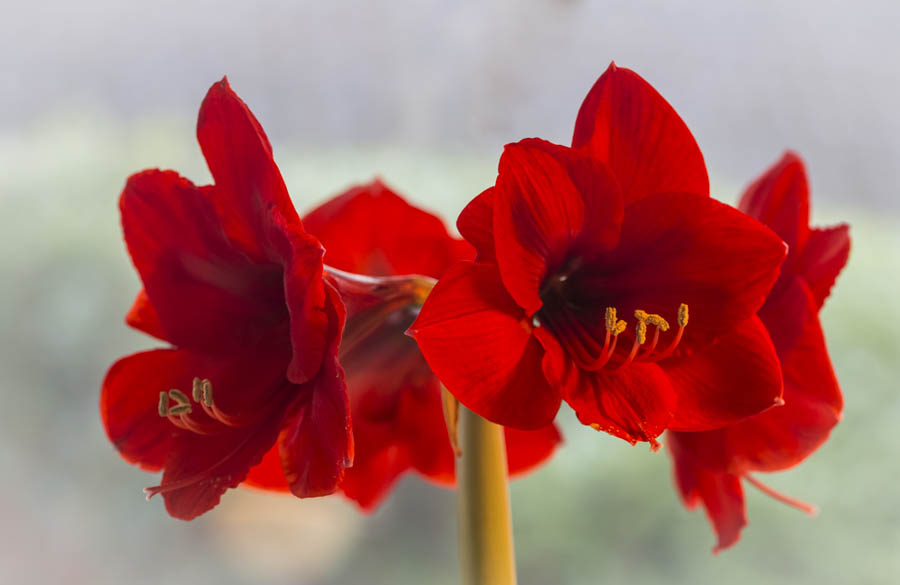Indoor and Potted Plants for the Holiday Season

GardenZeus receives commissions for purchases made through links in this post. There is no additional cost to you.
There’s nothing quite like live plants to bring up the holiday spirit and please a gardener’s heart. Some potted holiday plants and trees can survive indoors or when planted outdoors for months to years or even decades after the holidays, and they often don’t cost more than the price of 2 or 3 bouquets of cut flowers. Below are tips for favorites that are widely available during the holiday season.
Poinsettia (Euphorbia pulcherrima): Take special care with these fussy beauties. The most common reasons that poinsettias decline or lose their colorful bracts over the holidays are warm or cold temperatures, drafty conditions, insufficient light, and too much or too little water. They may decline at temperatures below 60 or above 70 degrees Fahrenheit, and may be damaged by several minutes of exposure to temperatures below 50°F. They need at least 6 hours of daily sunlight through a window or from an indoor fluorescent light, and prefer moist soil that isn’t wet or waterlogged. See Poinsettias: Tips, Care, and Fun Facts for the Holidays for compete information on growing poinsettias during the holidays.
Amaryllis (Hippeastrum cultivars): Hundreds of Amaryllis cultivars provide showy or even breathtaking single and double blooms in colors ranging from white to deep red, from salmon or peach to pink and maroon, and from solid single colors to striped and bicolored. Blooms may last weeks to months with proper care. Bulbs are welcome gifts for many gardeners who will grow them indoors after the holidays or even indoors/outdoors year-round. With proper care, some Hippeastrum species can survive and bloom for decades. Start early if you want to grow holiday Amaryllis from bulbs, in late September and October; many cultivars bloom 6 to 8 weeks after planting bulbs, but may take up to 12 weeks or longer. Be patient! Some Amarlyllis cultivars may take weeks to sprout leaves. During the holiday season, look for full-grown potted plants with healthy blooms or buds. Plant bulbs in pots with rich,well-drained potting soil and about 1/3 to 1/2 of the bulb above the soil surface. Water thoroughly, then allow soil to dry between waterings until bulbs sprout. Grow in a warm, sunny window after leaves emerge, and water more frequently during active growth and blooming so that soil stays slightly moist. Move plants to bright, indirect light when blooming begins.
Christmas Cactus (Schlumbergera species and hybrids): Despite the name, Christmas Cactus is a tropical epiphyte, meaning that it grows on trees or in nooks among rocks. Flower colors include white, pink, yellow, orange, red, and bicolors. Grow as an indoor plant in rich-but-well-drained soil, such as potting soil mixed with washed sand. Allow soil to dry slightly between waterings, and provide extra water while blooming. Plants bloom best when fertilized monthly from about March through October with a mild dilution of a balanced NPK fertilizer and a pinch or two of epsom salts in a separate feeding every 2 to 4 weeks. Christmas cactus needs plenty of bright light but avoid direct exposure to sunlight. Plants may be grown outdoors in bright shade during periods of mild daytime and nighttime temperatures.
Rosemary (Rosmarinus officinalis): Potted rosemary as trimmed to the shape of a mini Christmas tree can be a charming addition to holiday décor. Its lovely aroma is a welcome addition for many gardeners during the holidays. It grows well in potting soil mixed with washed sand, or in any moderately fertile soil that drains well. Allow soil to dry partially between waterings. Potted rosemary can thrive for years with occasional careful root pruning as needed in a medium or large pot, but may quickly overrun a smaller pot and suffer from being rootbound. Trim or pinch back frequently if you want to maintain compact, dense shape. Rosemary does not resprout from woody stems; take care to prune for stem structure and shape the plant while stems are still green. Rosemary does well planted outdoors in California Mediterranean areas with mild frost and winter temperatures down to about 25°F. It becomes very drought-tolerant once established in the ground. If kept in a pot, soak the entire pot in a bucket of water or run water through the pot for a few minutes every few months to flush soil salts that accumulate from evaporated water. Setting the pot outdoors during rainstorms will also flush salts.
Potted Christmas Trees: Various evergreen species are sold locally and by mail-order as potted Christmas trees during the holidays, including spruce, fir, cypress, and others. The vast majority of evergreen trees sold or shipped as potted Christmas trees won’t thrive and might not survive when planted outdoors in California Mediterranean areas. Norfolk Island Pine (Araucaria heterophylla) has an open form unlike the classic Christmas-tree shape of some spruce and fir species, but is often available as a potted holiday tree and survives well outdoors in Southern California coastal areas and mild-winter coastal-influence areas. If you want a live potted Christmas tree that you can plant outdoors after the holidays, try going to your local nursery and making a creative choice for an evergreen or other species suited to your climate, including those not necessarily sold as Christmas trees. You may find a species that can be trimmed into a Christmas-tree shape, or even if not, a tree that you can decorate now for the holidays, then enjoy in your outdoor landscape long after the holiday season has passed.
This is an updated version of an article originally published on December 5, 2018.
Other articles with holiday interest:
Gifts for Gardeners: Essential and Deluxe Tools for the Home Garden
Paperwhites for the California Holidays
A Holiday Kiss Under the…Holly?: Mistletoe for The California Holidays, Part 1 of 3
A Holiday Kiss Under the…Tree-Killing Parasite?: Mistletoe for The California Holidays, Part 2 of 3